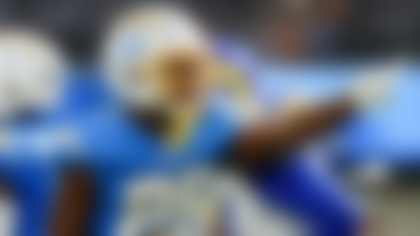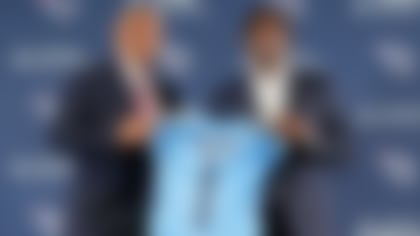Two weeks into his broadcasting career, CBS analyst Tony Romo has already established himself as one of the game's most distinct voices -- thanks in part to the prestige portion of his act.
In addition to the breezy digestion of complex schemes and coverages, Romo can predict the future. With startling accuracy, Romo has been able to point out what the offense or defense is doing before it actually happens, thanks to more than a decade of recent experience. America quickly noticed.
In a copycat world where TV executives have seen Romo's quarterback instincts create social media wildfire, it begs the obvious question: When will other analysts be forced to follow suit? Also -- why haven't they already?
"The thing that will most likely happen, though, like everything else in life and especially in our industry is, you start getting the copycats -- they'll start saying, Well who are we going to get?" longtime play-by-play man Bob Papa told me. "And you know what? There's going to be a lot of epic fails."
In conversations with Papa, the voice of the New York Giants, and long-time color analyst/NFL Network draft expert Mike Mayock this week, a few things became clear to me. First, Romo will force those who have been asleep at the wheel calling games for decades to get back into the film room. Second, what Romo is doing isn't necessarily new -- it's just perfectly raw and what he's comfortable with for now. Third, is the reason other analysts don't call out plays at a higher volume because they're afraid to be wrong?
When I re-watched Romo's first two games, Mayock was the first person who came to mind. Having taken in Notre Dame football nearly every fall Saturday since 1988, Mayock's arrival in the booth registered as fresh air. He was to Irish fans what Rush drummer Neil Peart became to rock and roll enthusiasts in the 1970s -- a mainstream entity who catered to those of us who appreciated the technical aspect of the craft.
Being the football teacher was Mayock's biggest strength, but it also became his main criticism.
"My feeling is that we tend to dumb down television in general, and football specifically," Mayock said. "I feel like there are a lot of television executives who think people at home don't want to learn anymore -- that it's too technical to even try. I get all of that, but I think there's a natural curiosity about the game of football that they're underestimating."
So what makes it work for Romo? According to Papa, it's being paired with Jim Nantz, quite possibly the most seamless storyteller on television. Romo can appeal to the junkies and Nantz can weave in a gentle narrative to keep the passive fan interested.
And soon, Romo will become more comfortable as a storyteller, too. He won't need to lean on what feels natural right now.
"Cris Collinsworth is the perfect example," Papa said. "If you watch his evolution over the years, not only is he a great analyst and great at identifying things ... but Cris has also become a master at weaving personal stories in. That's a prime-time standalone telecast every week -- you have to get the husband who's not the big football fan, the wife who is the huge fantasy football player -- you've got to get all the non-hardcores to care."
There are plenty of football fans who hope Romo stays just the way he is. While a telecast is more digestible with less hardcore X's and O's, it may not be better. How will Romo evolve?
"I remember, every once in a while, NFL Network dusts off Vince Lombardi diagramming with the chalk, the old sweep right with Fuzzy Thurston, Jerry Kramer -- his chalk is flying and he's got guards blocking down and people pulling and, you know, here comes Jim Taylor with the football," Mayock said. "I remember being a young kid, 8, 9, 10, and there was a beauty to that. I think the correlation between what you draw up for the players and the execution in the game, good or bad, there's a story there. There's a beauty to a great play."
Four more storylines that will define Week 3:
- James White: 73 snaps
- Mike Gillislee: 54 snaps
- Dion Lewis: 20 snaps
- Rex Burkhead: 18 snaps
Pro Football Focus helps provide us with a clearer picture of their surprisingly telling usage:
- White: 55 of his 73 snaps came on passing plays.
- Gillislee: 37 of his 54 snaps came on running plays (obvious given that Gillislee is the goal-line back).
- Lewis: 14 of his 20 snaps came on passing plays.
- Burkhead: 11 of his 18 snaps came on passing plays.
Much like Bill Belichick, who said last week that he had a hard time believing Saints coach Sean Payton wasn't going to mix up his backs, I have a hard time believing Burkhead and White will simply remain the go-to backs between the 20s and Gillislee will take over against the goal line or at the goal line. Against a Texans team that has had New England's number defensively in the past (just go back and look at Romeo Crennel's blitzes versus the Patriots in last year's playoff game), now might be a good time for a change.
3) Eagles more clearly defining Blount's role? Speaking of running back usage, the Philadelphia Eagles have used 2016 touchdown machine LeGarrette Blount on just 29 snaps this year -- the majority of them straight rushes for Blount (15) or plays where Blount, who is noticeably larger than any of his counterparts in Philly, has to stay in and pass-protect (5).
Just as questions about Blount's role began to surface, the Eagles began prepping for a game against the New York Giants (0-2). Perhaps the only thing the Giants do well at this moment is defend the run with their excellent front four.
Here's Eagles head coach Doug Pederson on Blount from this week: "He and I talk all the time, quite honestly. We spoke last week, we spoke going into the Redskins game. I think it's important that you define the role for guys, and here's my expectations for players. I think it's important. And even the position coach, to have that conversation with players at their position, and listen, we only have -- we've got one football, and you try to get everybody involved when you can and if you can. But yeah, I mean, he and I, we've had conversations and just defining the role."
Pederson also said he wouldn't be uncomfortable getting Darren Sproles, the team's most utilized running back, 150 touches this season.
4) Who's calling the plays in New York? The Giants-Eagles game this weekend might feature an interesting passing of the torch. Head coach Ben McAdoo said he would consider everything to jump-start his stagnant offense, including surrendering play-calling duties. Here was a terse conversation with reporters on the subject this week:
Q: Will you be calling the plays this week?
A: We'll see.
Q: Is calling the plays a coaching decision, or is Jerry Reese involved?
A: It's my decision.
Q: Would you tell us your decision on who is calling the plays?
A: No. I would never tell you that.
Q: Is the play-calling decision one you are still considering?
A: We'll do anything we can do to help us move the ball.
Q: Are you still considering who will call the plays?
A: Yes.
McAdoo does have an ace in the hole should he make the move: offensive coordinator Mike Sullivan, who was Eli Manning's quarterbacks coach during his first "rebirth" season in 2011. Sullivan has always been a Manning whisperer, though his experience with Eli is obviously rooted in Kevin Gilbride's offense, where the QB would be sent to the line with three plays, given time to dissect the defense and then choose the best option.
The question is, would McAdoo, who waited a long time to be put into a situation where he could call plays (Mike McCarthy was the primary play caller in Green Bay) give it up so quickly? I'm not sure changing play callers can circumnavigate the team's biggest problems -- no run game and a struggling offensive line -- which require the Giants to add more protection at the line for Manning at the cost of having fewer eligible receivers against a multitude of defenders.
5) Football returns to London. The NFL begins its most comprehensive London series to date Sunday, with a 9:30 a.m. ET kickoff between the 2-0 Ravens and the 1-1 Jacksonville Jaguars.
Here's what you need to know:
-- This is Baltimore's first international game. Back in 2015, a few members of the Jaguars organization told me in London that it took them a few years to figure out the logistics that worked best for them. Fly out early and acclimate to the plus-five-hour time difference, or fly out extremely late and hope to miss it altogether? Fly late at night and hope your best players in first class can sleep on the flight? Fly in the morning and crash when you arrive? The Ravens will be at a bit of a disadvantage, given all the tinkering the Jags have been able to do with London as their second home. Will it show on Sunday?
-- The Jaguars are 2-2 at historic Wembley Stadium, having won two in a row. Can they make it a third straight?
-- One fun memory from London: Back in 2015, I met a U.K.-based Jaguars fan in an authentic Blake Bortles jersey who said he became a Jacksonville fan for one simple reason:
"You guys pronounce the name wrong, it's hilarious," he said. "It's Jag-Ewe-Ars, not Jag-Wires."











